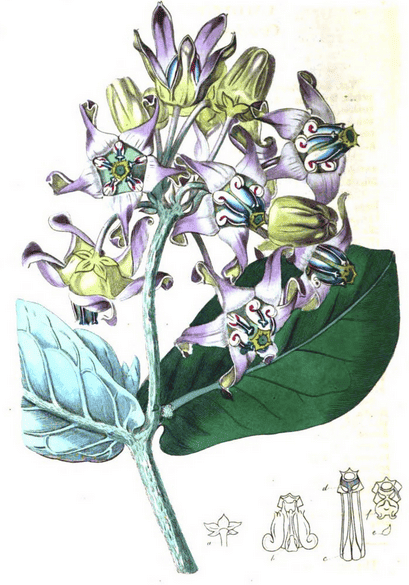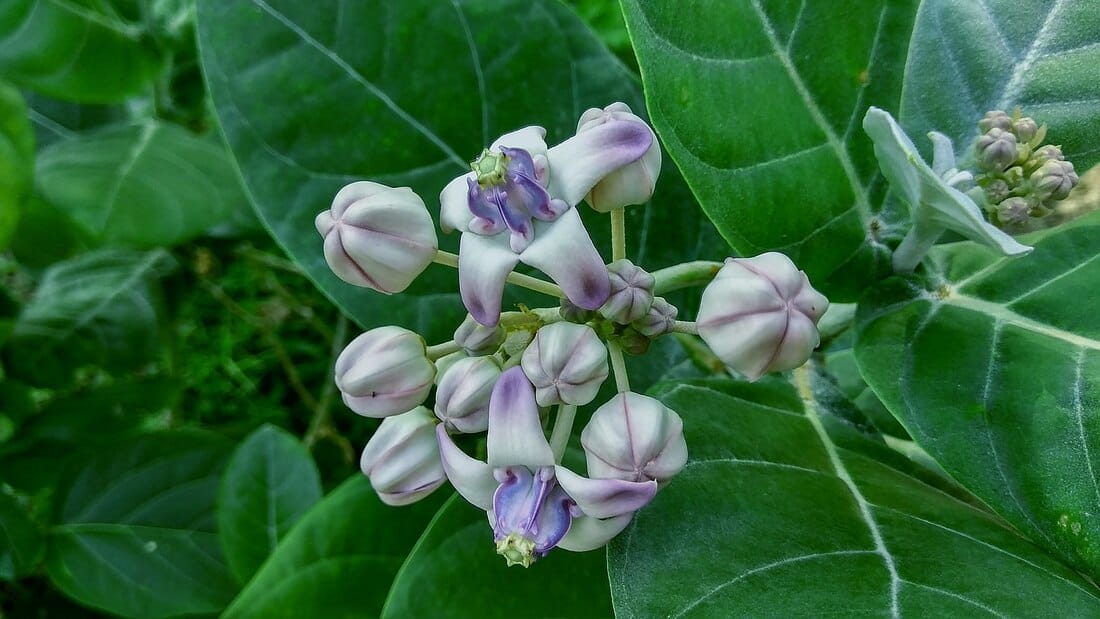Calotropis, Swallow-wortVasuka, Mandara, Arka (Ayurveda)Aak, Madar, Ushr (Unani) |

|

|
 The Botanical Register, Edwards & Lindley, 1815
The Botanical Register, Edwards & Lindley, 1815 Calotropis gigantea
Calotropis gigantea(Photo by ShahadatHossain) (Wikimedia)
Botanical name:
Calotropis gigantea, C. procera
Parts used:
Root bark, juice, flower
Temperature & Taste:
Hot, dry. Pungent, Bitter. Toxic
Avicenna said Hot in the 2nd Degree but Dry in the 4th Degree.
Caustic, burning, rubefacient
Uses:
1. Purges Phlegm and Damp: (root-bark; juice)
-Ascites, anasarca
-chronic skin diseases including Leprosy; constitutional Syphilis
-Cough, Asthma
-chronic rheumatism,
2. Externally
-rubefacient and caustic
-“Its paint is useful in Porrigo and Ringworm“. (Avicenna)
-“Its paint is also useful in cases of Stomatitis in children”. (Avicenna)
Dose:
Root-bark in decoction: 5–10 grams
Leaf in Powder: 250mg–1 gram
Substitute:
1. Croton seed (Unani)
2. Ipecac (Waring)
Correctives:
Black Pepper, Ghee, Milk
Main Combinations:
1. Bronchial Asthma:
i. Calotropis flower with Black Pepper (equal parts), powder and form pills of 125mg each. Dose: 1–2 pills, traditionally taken with a Betel leaf. (Siddha)
ii. Calotropis root-bark (30 grams) with Aconitum napellus (Beesh), prepared (15 grams), Ginger juice (3 liters). Powder the herbs then triturate with the Ginger juice until absorbed. Then mix with mucilage of Gum Arabic and form pills. Dose: 125–250mg (as in Habb e Hindi Zeeqi)
Major Formulas:
Habb e Hindi Zeeqi
Cautions:
1. Toxic and irritant. Use very cautiously
2. Not used in Pregnancy.
3. Avicenna said 10 grams of the Latex “proves fatal with severe damage to the lungs and liver of the patient within two days”.
Main Preparations used:
Dehydrated Juice
-
Extra Info
-
History
|
‘Calotropis is mentioned by the earliest Hindu writers, the leaves, arkapattra, arkaparna, “sun leaf” or “lightning leaf,” so called from their cuneiform shape, were used in Vedic times in Sun-worship. According to the Shatapatha Brahmana every part of the human form was supposed to be represented in the different parts of the plant, nevertheless it would appear to have been dreaded (Panchatantra i. 57), and was supposed to blind those who approached it. (Mahabharata. i. 716.) These myths appear to have arisen from the Hindus attributing to the plant the properties possessed by lightning and the sun’s rays. (De Gubernatis.) As a medicine Calotropis is noticed by Susruta and other medical writers, some of whom mention two varieties, arka, and alarka, “a white-flowered kind.” Calotropis bears many synonyms in Sanskrit, such as Rudra, Aditya, Surya-pattra and Mandara, from the last of which is derived the vernacular form Madar. In Western India, and probably elsewhere, there is a curious superstition that a leaf of the Akra (Arka) fetched from the tree with certain ceremonies is of use in tedious labour. The friends of the woman take a packet of betelnut and leaf and a piece of money, and proceed to the plant, which they address in the most respectful manner, placing the betel packet at its root and asking for the loan of one of its leaves, which they promise to return shortly. They then take away a leaf and place it upon the head of the parturient woman, where it remains for a short time, and is afterwards returned to the plant. This practice appears to be connected with the worship of the Maruts or winds, demigods subject to Rudra, to whom these plants are sacred. The Maruts are worshipped on Saturday with a garland of the flowers. The twigs are used as samidhas, and the leaves are used by some in tho shati puja to propitiate the goddess of parturition. Calotropis is also the kull or Arbor generationis of the Bhandari caste, whose business it is to tend the palm gardens and extract the juice of the trees. Another custom general amongst all castes of Hindus is that a man who has lost three wives must make his fourth marriage with the Arka tree, after which he may take a fourth human wife. The object of this seems to be to transfer the man’s ill-luck to the plant. The ancient Arab tribes appear to have held superstitious notions about Calotropis, probably connected with Sun-worship. C. procera was first described by Abu Hanifeh circa 270. A. H. in his Book of Plants. From the Kamus and the Taj-el-arus we learn that Ushar was used by the Arabs in the Time of Ignorance along with (salaa) in the practice called (tasliaa) which was observed in time of drought or barrenness of the earth. It consisted in tying the dried plants to the tails of wild bulls, setting fire to them, and driving the animals down from the mountains, seeking to obtain rain by the flame of fire, which was likened to the gleaming of lightning. The Salaa from Abu Hauifeh’s description appears to have been a kind of Cuscuta. According to the Burhan, (ushr) is a Persian name for all plants having a milky juice, and especially for the plant known in Hindustan as Ak. It would therefore seem that Ushar is not an Arabic word, as generally stated in the Dictionaries, but of Arian origin, and perhaps connected with the Sanskrit verb to burn. The wood is considered to make the best charcoal for the preparation of gunpowder, and Ushar silk is used to stuff cushions by the Arabs, and also to make tinder (makhad), called by the Tartars yalish. Ibn Sina notices Ushar, and an exudation obtained from it called Sakar-el-usha; he also mentions a superstitious notion that it is fatal to sit under the tree. The author of the Minhaj describes Sakar-el-ushar as a gum which exudes from the inflorescence of the plant and gradually hardens. (He remarks that people say that it is a dow which falls upon the plant and concretes like manna.) Some medical writers confound it with Sakar-el-tighal. Abu Hanifeh and the author of the Obab describe it as an exudation from the flowering parts of the plant. The best authorities describe its properties as similar to those of the juice of the plant, it would therefore seem to be nothing more than an exudation of the juices of the plant which naturally contain some sugar. Calotropis is not mentioned by Greek or Roman writers, but some Mahometans give Hejakiyus as it Yunani name; this appears to be a corruption of the word [?], “most holy,” or ” under divine protection,” and was probably applied to the plant by some of the Syrian physicians who instructed the Arabs in Greek medicine. The modern Persians call C. procera Khark and Darakht-i-zahrnak, or “poison tree.” By Hindu physicians the root bark is said to promote the secretions and to be useful in skin diseases, enlargements of ‘the abdominal viscera, intestinal worms, cough, ascites, anasarca, &c. The milky juice is regarded as a drastic purgative, and caustic, and is generally used as such in combination with the milky juice of Euphorbia neriifolia. The flowers are considered digestive, stomachic, tonic and useful in cough, asthma, catarrh and loss of appetite. The leaves mixed with rock salt are roasted within closed vessels, so that the fumes may not escape. The ashes thus produced are given with whey in ascites and enlargements of the abdominal viscera. The following inhalation is prescribed for cough :Soak the powdered root bark of Arka in its own milky juice and dry. Bougies are then prepared from the powder, and |
their fumes inhaled. The root bark, reduced to a paste with sour conjee (rice vinegar), is applied to elephantiasis of the legs and scrotum. The milky juices of C. gigantea and Euphorbia neriifolia are made into tents with the powdered wood of Berberis asiatica, for introduction into sinuses and fistulae in ano. The milky juice-is applied to carious teeth for relief of pain. An oily preparation (Arka taila) made by boiling together 8 parts Sesamum oil, 16 parts Calotropis juice, and one part turmeric, is said to be useful in eczema and other eruptive skin diseases. In the Concan the milk with powdered mustard is applied as a lep to rheumatic swellings, the flowering tops pounded and boiled with molasses, are given in doses of about one drachm every morning as a remedy for asthma. In want of virility the following prescription is in vogue: Take 125 of the flowers, dry and powder, then mix with one tola each of cloves, nutmegs, mace and pellitory root, and make into pills of six massas each, One pill may be taken daily dissolved in milk. The author of the Makhzan-el-aduriya says there are three varieties of Calotropis— 1st, a large kind with white flowers, large leaves, and much milky juice, it is found near towns and the habitations of man; 2nd, a smaller kind with smaller leaves, the flowers white externally but lilac within; 3rd, a still smaller plant, with pale yellowish green flowers. The second and third kinds grow in sandy deserts. The properties of all three are similar, but the first kind is to be preferred, as it produces the largest quantity of milk. The juice is described as caustic, a purge for phlegm, depilatory, aud the most acrid of all milky juices. Tanners use it to remove the hair from skins. Medicinally. it is useful in ringworm of the scalp, and to destroy piles; mixed with honey it may be applied to aphtha of the mouth; a piece of cotton dipped in it may be inserted into a hollow tooth to relieve the pain. Hakim Mir Abdul Hamfd, in his commentary upon the Tuhfat, strongly recommends Calotropis in leprosy, hepatic and splenic enlargements, dropsy and worms. A peculiar method of administration is to steep different kinds of grain in the milk and then administer them. The milk itself is a favourite application to painful joints, swellings, &c, the fresh leaves also, slightly roasted, are used for the same purpose. Oil in which the leaves have been boiled is applied to paralysed parts; a powder of the dried leaves is dusted upon wounds to destroy excessive granulation and promote healthy action. All parts of the plant are considered to have valuable alterative properties when taken in small doses. C. procera was observed in Egypt by Prosper Alpinus (A. D. 1580— 84), and upon his return to Italy was badly figured, and some account given of its medicinal properties. (De plantis Aegypti, Vonet. 1592, cap. 25.) A much more correct figure was published in 1633 by his commentator Vesling. Rheede (Hort. Mal .ii.,t.31) figures a white-flowered Calotropis (Bel-ericu) and a lilac (Erica), and Rumphius (Hort .Amb. vii.,t.14,f.1) figures C. gigantea under the name of Madorous. Roxburgh (II.,30,) gives a botanical description of C. gigantea under the name of Asclepias gigantea, and mentions the medicinal uses to which it is applied by the natives of India. Ainslie, in his Materia Medico of Hindustan, (1813), mentions two kinds of Calotropis, and in the Materia Indica he says, “Both plants in their leaves and stalks contain much milky juice, which, when carefully dried, is considered as powerfully alterative and purgative, and has been long used as an efficacious remedy in the Koostum (lepra Arabum) of the Tamools; the dose about the quarter of a pagoda weight in the day, and continued for some weeks. The root of the Yercum has a bitter and somewhat acrid, or rather warm taste; it is occasionally given in infusion as a stimulant in low fever. Of the other variety, the Vullerkoo, the bark is warmish, and when powdered and mixed with a certain portion of margosa oil, is used as an external application in rheumatic affections. In the higher provinces of Bengal the Arka is supposed to have antispasmodic qualities. Mr. Robinson has written a paper on elephantiasis, which may be seen in Vol. X. of the Journ. of the Medico-Chirurgical Society, extolling the madar root (Yercum vayr) as most efficacious in that disease, as also in venereal affections. In elephantiasis lie gave it in conjunction with calomel and antimonial powder, in a pill, consisting of half a grain of calomel, three of antimonial powder, and from six to ten of the bark of the madar root, every eight hours. Mr. Playfair has also written a paper on the same root which may be seen in Vol. I. of the Edin. Med. Chirurg. Trans., p. 414, wherein he speaks in praise of the alterative, stimulant, and deobstruent virtues of the bark, or rather rind below the outer crust of the root, reduced to fine powder, in cases of syphilis, lepra, hectic fever, &c, dose from grs. 3 to 10 or 12, three times in the day, gradually increasing it. Messrs. Robertson, Playfair, and others seem chiefly to dwell on the virtues of the rind or bark of the root; but I must observe, that in Lower India, where I was for many years, I found the simple dried milky juice considered as infinitely more efficacious; and later communications from the East confirm me in this opinion.” (Op.cit.I., p. 487.) (Pharmacographia Indica, Dymock, 1891) |
